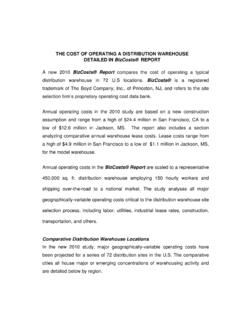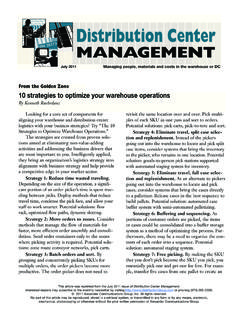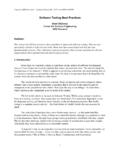Transcription of Consortium Report Benchmarking & Best Practices
1 Benchmarking & best Practices Cycle Counting Increase Inventory Accuracy & Eliminate Wall-to-Wall Physical Inventory Consortium Report April 10, 2012 Bruce Tompkins Executive Director Supply Chain Consortium (919) 855-5527 Chris Ferrell Director Supply Chain Consortium (407) 362-0369 Page 2 Consortium Report : Inventory Accuracy Through Cycle Counting Copyright 2012 Supply Chain Consortium . All rights reserved. Confidential and Proprietary. Introduction High levels of inventory accuracy are critical to the success of any warehousing operation. Inaccurate inventory can cause increased operating costs, low service levels, poor customer service, and higher inventory levels. One of the best ways to combat inventory accuracy issues is with a proactive cycle counting program. These programs are effective tools that improve inventory accuracy.
2 Although a sound cycle counting program cannot always deliver perfect accuracy, it can deliver the following results: Uncover the root causes of inventory discrepancies by taking timely corrective action to eliminate (or reduce) future discrepancies. Increase distribution operation labor efficiency, improve product flow and boost customer service by identifying and correcting inventory discrepancies before they impact normal operations. Meet the requirements of the accounting department and external auditors procedural controls, count frequency and inventory accuracy levels eliminating costly wall-to-wall physical inventories. Provide the appropriate tools, processes and procedures to optimize the deployment of inventory control resources and maximize cycle counting efficiency, enabling inventory control personnel to quickly identify and resolve inventory discrepancies.
3 Educate the entire operations team on the importance of having accurate item-level inventory, as well as successfully implementing and executing the cycle counting program. Provide the resources to track and Report compliance and performance against a set of predefined key metrics, and hold individuals accountable for maintaining targeted inventory accuracy levels. Allow for reduction in safety stock levels as a result of higher accuracy and improved service levels. Proactive cycle counting programs combat inventory accuracy issues. Page 3 Consortium Report : Inventory Accuracy Through Cycle Counting Copyright 2012 Supply Chain Consortium . All rights reserved. Confidential and Proprietary. Inventory Accuracy Inventory accuracy can be measured in a number of ways. For Report purposes, inventory accuracy is defined as the number of correct cycle counts as a percentage of total annual cycle counts.
4 Counts should be measured by the number of storage slots. A correct count is determined by a match of product quantity and location to the data in the inventory system. Inventory accuracy data from the Tompkins Supply Chain Consortium in Figure 1 shows the typical range of accuracy for organizations with cycle counting programs. Top-performing companies are capable of inventory accuracy greater than 99%, while the average company can achieve 98%. For organizations not performing at these levels, there are opportunities for improvement. Inventory Verification Methods While cycle counting is an effective means of managing inventory accuracy, some companies still use a combination of cycle counting and physical inventory to maintain accurate inventories. A small and shrinking number of companies still use physical inventory as their only means to verify and monitor inventory accuracy, as shown in Figure 2.
5 Top-performing companies are capable of inventory accuracy greater than 99%. Figure 1. Inventory Accuracy Percentages Top Quartile Second Quartile Average Third Quartile Bottom Quartile Figure 2. Inventory Accuracy Verification Methods 4448%47%5%Physical Inventory & Cycle CountingOnly Cycle CountingOnly Physical Inventory Page 4 Consortium Report : Inventory Accuracy Through Cycle Counting Copyright 2012 Supply Chain Consortium . All rights reserved. Confidential and Proprietary. Inventory Verification Methods (Continued) Nearly 50% of companies still do physical inventories. Figure 3 shows how frequently companies perform physical inventory. Presumably, company and auditor policies drive many of the more frequent physical counts. And, 41% of companies are on the traditional annual physical cycle. Cycle Count Frequency A number of factors impact the frequency of cycle counting individual part numbers.
6 The Supply Chain Consortium asked member companies about factors that influence cycle count frequency and received the following response (Figure 4). The main factors for cycle counting and current inventory accuracy include accountant and auditor criteria. Many of the other elements unit dollar volume, annual dollar turnover, and more play a role in the overall development of the cycle count program, determining frequency on specific items. Nearly 50% of companies still do physical inventories. Figure 3. Frequency that Physical Inventory Is Performed13%21%21%41%4%MonthlyQuarterly SemiannuallyAnnuallyLess than annuallyFigure 4. Factors Impacting Cycle Count Frequency Importance Rating* Criteria Set By the Accounting Department or External Auditors Current Inventory Accuracy Unit Dollar Value Locations in Close Proximity Counted on the Same Cycle Emptying of a Pick Location Initiates a Cycle Count or Reconciliation Annual Dollar Turnover of an Item Annual Unit Volume Pilferage Risk External Regulations *Importance rating from 1 to 5 with 5 being of highest importance Page 5 Consortium Report : Inventory Accuracy Through Cycle Counting Copyright 2012 Supply Chain Consortium .
7 All rights reserved. Confidential and Proprietary. Cycle Count Frequency (Continued) Figures 5 through 7 indicate the changes in cycle count frequency when moving from low-to-high priority parts. In most cases, cycle count frequency increases with part priority. Figure 5. Cycle Count Frequency Performed for Low-Priority Parts 12%15%40%24%9%WeeklyMonthly Quarterly Annually Less than annuallyFigure 6. Cycle Count Fequency Peformed for Medium-Priority Parts 3%18%21%46%12%WeeklyMonthly Quarterly Annually Less than annuallyFigure 7. Cycle Count Frequency Performed for High-Priority Parts3%3%43%18%33%WeeklyMonthly Quarterly Annually Less than annually Page 6 Consortium Report : Inventory Accuracy Through Cycle Counting Copyright 2012 Supply Chain Consortium . All rights reserved. Confidential and Proprietary. How to Count There are four distinct processes to consider when recording cycle counts against a slot in a warehouse.
8 1. Scheduled cycle counts are the proactive counts (or normal counts) that are completed daily based on a set of predefined rules and procedures. Cycle counters are directed by the system to count slots in the most efficient travel path possible. For scheduled cycle counts, ensure that the counts are blind and that the system shows the location. Also, make sure the cycle counter scans the item and enters the unit or case count. 2. Zero confirmations are opportunistic counts performed by warehouse operators during the course of normal day-to-day warehouse operations. Similar to scheduled cycle counts, zero counts are recorded as a valid cycle count and can be used for meeting the minimum slot and SKU count requirements of the program. 3. Slot verifications are triggered when either a normal warehouse operation or a cycle counting operation uncovers a count discrepancy within a slot and the discrepancy is greater than the predefined acceptable variance threshold.
9 An inventory control resource will be directed by the system to slots that have pending slot verification requests based on priority and the most efficient travel path. Resolving the discrepancy at the location in question will eliminate the need for inventory control to do a full SKU verification. 4. SKU verifications occur when the slot verification confirms that a count discrepancy exists. Set up the SKU verification process to sequence the slots being verified so that the slots with the highest probability of having the off-setting inventory discrepancy are visited first. The goal of the slot and SKU verification process is to minimize the time and labor required to resolve discrepancies, while maintaining a high degree of inventory integrity. Utilize scheduled cycle counts, zero confirmations, slot verifications and SKU verifications when recording cycle counts.
10 Page 7 Consortium Report : Inventory Accuracy Through Cycle Counting Copyright 2012 Supply Chain Consortium . All rights reserved. Confidential and Proprietary. Performing Cycle Count Duties The completion of a cycle count program requires the involvement of five different organizational titles: Distribution center (DC) staff or warehouse operators Cycle counters Inventory control specialists Inventory control managers DC managers Several different activities are involved in a cycle count program. These include scheduling and conducting the counts, as well as making adjustments to the inventory records after cycle counts are complete. The title of the individual who has the authority to perform these roles varies greatly by company. Figure 8 identifies the percentage of respondents representing the major job titles of DC staff, cycle counter, inventory control specialist, inventory control manager and DC manager.













